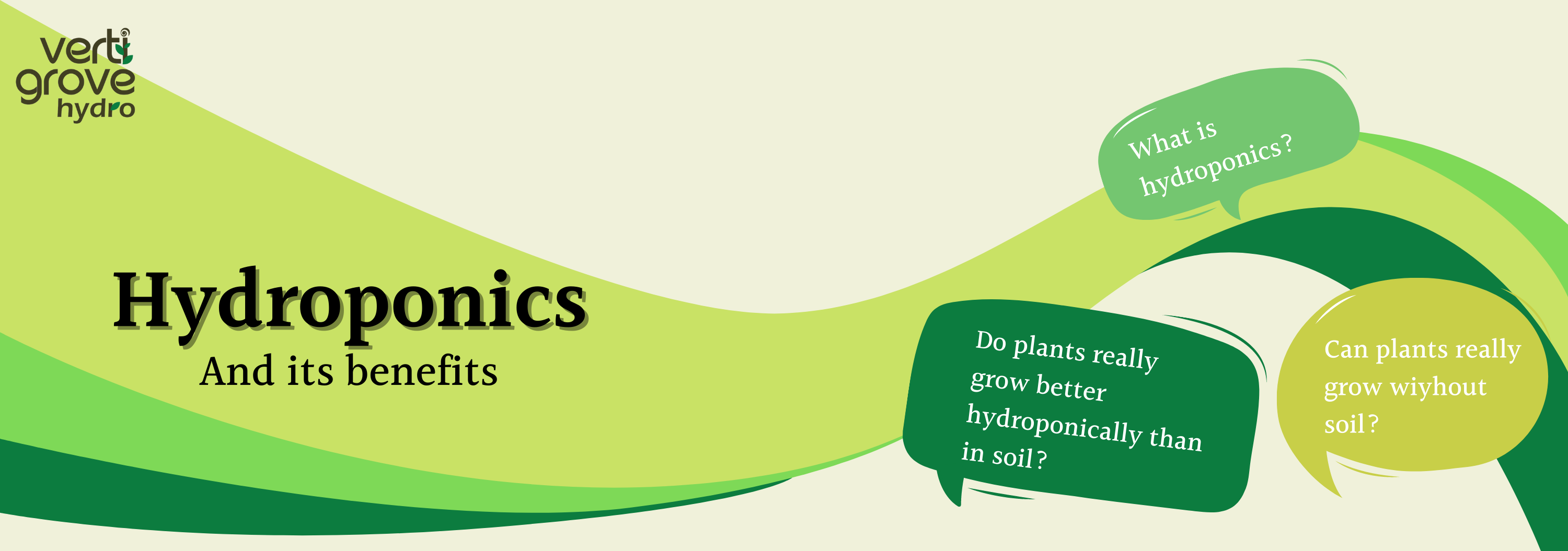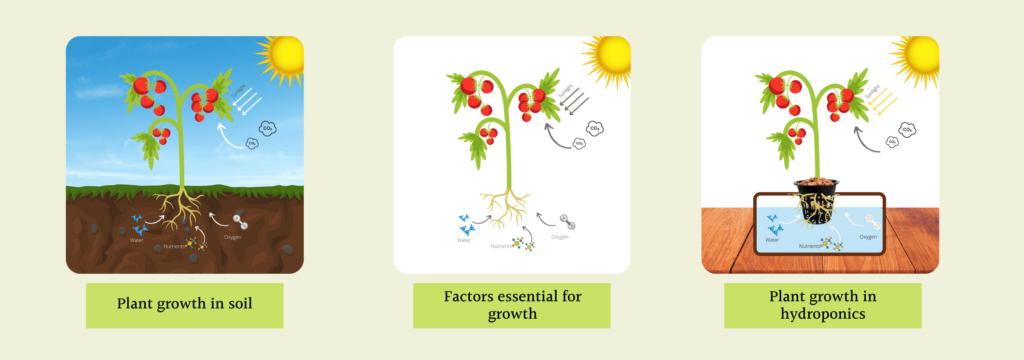
Hydroponics is a fast-growing concept and is reaching commercial and home growers at a fast rate. The increase in popularity of the technique is simply because of its significant advantages when compared to soil farming. A better understanding of the science behind hydroponics is helping growers to maximize their yield with minimum resources.
Let’s get into the basics of hydroponics. Hydroponics is basically a technique of growing plants without soil! It is a method of growing plants in water with the essential nutrients dissolved in it. The plants are placed in net pots such that their roots are in touch with nutrient rich water and the plants are secured in the net pot usually using clay balls.
But, how can plants grow without soil?
A lot of people are surprised to know that plants can grow with out any soil! So, let’s dive into how that’s possible. For this, first we need to understand what a plant needs to grow. As we all know, plants grow through a process called photosynthesis, in which they convert water, minerals and carbon dioxide in the presence of sunlight and chlorophyl into glucose and oxygen.

If you have noticed, there’s no mention of soil here! Plants grow in soil because it contains water and minerals. So, if plants get these by standing with their roots in a mineral rich water solution, they can do without soil altogether.
There are variety of hydroponic systems, but all have certain basic common requirements for plant growth:
- Light: Both fruiting and leafy vegetables require a minimum of 6 hrs. of sunlight for proper growth. In case of indoor hydroponic system this will be substituted by artificial lights.
- Water: Water used in hydroponic system is very crucial. Filtered water with a balanced pH is required. Most plant grow best at an optimum pH between 5.5-6.5. The pH of your water can be adjusted using pH up & down solutions.
- Nutrients: Plants require 17 essential nutrients for proper growth and development. Since the plants aren’t growing in its natural environment, the grower needs to provide it “food” in the form of nutrient solution. Pre-mixed nutrient solutions are available and it simply needs to be added to the water.

- Root Support: Since in hydroponic systems there is no soil involved it is necessary to provide the plant roots support so that the plants stand straight. For this we need to use materials that can retain moisture, such as clay balls, leca balls, peat moss, perlite, vermiculite, etc.
- Oxygen: Plant roots need access to oxygen in order to absorb nutrients efficiently. When grown in soil, plants get oxygen from air pockets present in the soil. In hydroponic systems, many growers make the mistake of drowning their plant roots in water. This will adversely affect plant growth. To avoid this, we need to ensure that there is sufficient space between the base of the plant and the water level, or add oxygen using air pumps or by creating bubbles.
Do plants grow better hydroponically than in soil?
Yes, it’s proven that plants show much better growth when grown hydroponically. This is simply because the plants are getting the right nutrients at the right stage in the form that it can be easily absorbed. Plants can absorb nutrients only in its ionic form. The major difference in the nutrients in soil and in hydroponic method is that the former requires bio-active intervention before it can be absorbed and the latter is ready for immediate uptake.
Plants require mainly 3 elements for proper growth: Nitrogen, Phosphorous and Potassium.

Plants cannot directly absorb nutrients from fertilizers or manure present in the soil. For example, let’s look into how plants absorb nitrogen.

What we need to understand is that the nutrients that plants absorb in hydroponics are exactly the same as the ions resulting after this complex process. So, in hydroponics plants can absorb the nutrients faster and much more easily and hence they grow faster, produce higher yields and are much more nutritious as well.
Advantages of hydroponics

- Space saver
Unlike soil farming, where you need a large area to set-up a farm, hydroponics requires significantly less space to set-up the same number of plants. Moreover, if hydroponics is coupled with vertical gardening it is possible to grow in 90% less area in comparison to conventional farming techniques.
It is possible to crowd plants in hydroponics mainly because plant roots don’t have to go very deep in search of nutrients. Water and nutrients are available for uptake at the roots constantly or intermittently depending on the type of hydroponic system. This means that each plant’s root system will occupy far less space in comparison to when grown in soil. Hence, you can grow a greater number of plants in the same space. - Conserves Water
Even though in hydroponics plants are grown in a water medium, it uses much less water in comparison to soil farming. In fact, it is proven that plants need 90% less water when grown hydroponically. In hydroponic
systems water is constantly being circulated and hence can be recycled and replenished with nutrients. This means that plants absorb the water they need and the rest of the water remains in the system and is re-circulated. - Less pest attacks
Plants grown hydroponically are healthier and thus have a greater immunity. This makes them able to resist pest attacks to a certain level. Also, there is no question of soil borne pests in hydroponics and hence that can be completely ruled out. - Less labor intensive
In hydroponic systems there is no need for weeding, tilling, watering each plant, etc. Since, no soil is involved there is no weeding or tilling that needs to be done. In most hydroponic systems, water is constantly being circulated, hence there is no need to manually water each plant. The reservoir needs to be topped off with water and TDS (nutrient levels) need to be adjusted once in a while. Since these can be done centrally for all plants, it makes hydroponic farming much less labor intensive. - Faster growth and higher Yields
Since plants are getting the right nutrients at the right time, plants grow 30-50% faster in hydroponic systems in comparison to traditional methods of farming. When grown in soil, plants take months to reach fruiting and ripening stage. This is simply because in soil, plant roots have to go deep in search of nutrients required for proper growth. Whereas in a hydroponic system, the required nutrients depending on the stage of growth is made available to the plant at its root. - Nutrient Control
The grower has proper control on the nutrients that the plants absorb when grown in hydroponic systems. In hydroponic systems, the grower can measure the level of nutrient available in the solution using a TDS meter and can adjust the quantity according to the stage of plant growth. Also, pH of the medium is very critical to ensure that plants can optimally absorb the nutrients. In hydroponic systems, you can easily measure the pH and make correctives using pH up or pH down solutions that are available easily.
If you are interested in setting up your own hydroponic garden in your home balcony, give Vertigrove-hydro a try! Vertigrove-hydro is a vertical hydroponic system in which you can grow upto 36 plants in just 4 sqft. It is designed exclusively for urban dwellers who have space and time constraints. Contact us here to know more.
